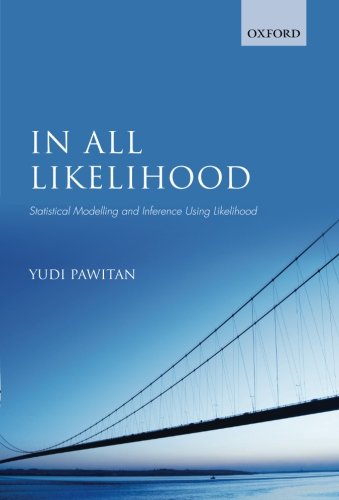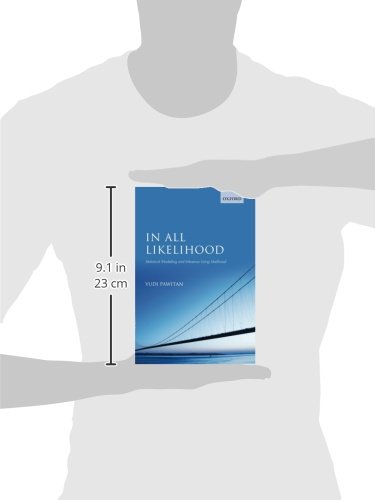


Full description not available
M**R
Modern, elegant, flexible, and nuanced approach to applied statistics
As a practicing data analyst, I frequently find the standard "classical" statistical techniques either useless, cumbersome, or convoluted for all but the most straightforward applications. However, before running across the book, I thought my only other option would be to utilize Bayesian methods (which are infinitely more flexible and elegant) to perform inference with complex, non-normal/non-linear models. Unfortunately, solving Bayesian models relies on two rather unappealing concepts: a prior probability (so that all your calculations still yield probabilities),and Markov Chain Monte Carlo (a computationally intensive, sometimes non-convergent, algorithm that is only asymptotically correct wrt the true Bayesian posterior probability distribution.)Reading Dr. Pawitan's book introduced me to a very satisfying "third way" as he calls it. Instead of force-fitting all uncertainty into a probability, the "likelihood" approach recognizes two types of uncertainty, which is both novel in statistics and extremely refreshing once you understand why two types are necessary. The first, which I would call "well calibrated" uncertainty, is analogous to a confidence interval for the mean of a normal sample. With this type, we know how often we would be wrong under repeated sampling from this population, so we have a good idea how well our method brackets the true mean i.e., well calibrated.The other type of uncertainty is unique to the likelihood approach. This type of uncertainty arises if precise, repeated sampling error rates cannot be derived or estimated. In this case you are left with basically two choices (apart from collecting more data): create asymptotically well-calibrated inferences (i.e., assume that as N -> infinity, your repeated-sampling probability statements would become more precise) or admit that you do not precisely know the error rate and then rely solely on the likelihood and perhaps some non-frequentist calibration metric (Dr. Pawitan shows how to do this using the AIC to "calibrate" the likelihood). This type of uncertainty is NOT stated in terms of probability, which I find incredibly honest, as giving probabilities gives the air of more accuracy/knowledge than is usually warranted with complex models.From an applied standpoint, I think the likelihood approach is superior to the Bayesian approach not because it is necessarily more accurate, but because it possesses a far less cumbersome theoretical apparatus while retaining all the flexibility and elegance of a Bayesian approach. Likelihood methods do not require Markov Chain Monte Carlo, nor do they require jacobians for transformations on inferences - instead, all you need is a good old "root finder" to solve essentially all problems. Simulation is useful if you are doing bootstrapping along with likelihood, but it is not an essential part of the "inference machine" so to speak. For missing data, you can use Expectation Maximization, which again only requires a simple computer package. Finally, you can incorporate prior information (subjective opinion or objective/data) as a prior likelihood, which unlike the prior probability does not need to integrate to one (in Bayesian stats, you have to resort to "improper priors" and hope for the best for situations where you want to represent complete ignorance). Also, a prior likelihood is probably psychologically closer to what most of us do when we evaluate the prior plausibility of a hypothesis, as we usually aren't very good at estimating raw probabilities.The actual book is very complete, with good coverage of the fundamental mathematical statistics. Sometimes he could be clearer about his motivation for a particular topic, but overall I found it an excellent applied statistics text with great theoretical underpinning. If you are looking for a modern, flexible, and nuanced approach to applied statistics, you can do no better than this book.
J**N
Excellent book---well worth the money
I first heard about this book in 2006 at the International Meeting of the Psychometric Society (in Montreal) from a colleague. I ordered it from Amazon the day I heard about it from one of the conference computers. It's great and I've found examples in it for teaching plus a lot of things that I simply didn't know, didn't remember, or didn't really understand the first time.The examples make this book really useful compared to more technical texts like Bickel & Doksum or Lehmann. (These books are useful, of course, but not so much as texts for courses.) Pawitan's book has tons of really great little examples that bring the concepts down to earth for the reader. For instance, when he plots four score functions (normal, Poisson, binomial and Cauchy), you *see* immediately why estimation is more difficult in models such as the Cauchy compared to the normal. It also builds intuition about what the score function actually is. I have unpublished notes from John Marden (Statistics, UIUC), who was my statistical theory professor, which are very, very good. Pawitan's book is on par. The fact that the R code is available is fantastic.
K**Y
Best Book on Likelihood
Excellent coverage of likelihood, with significant depth. Explanations are very clear, but forewarned they are targeted at a higher level audience. I'm thinking advanced undergrad stats course or entry level grad textbook. This is a textbook with lots of math, but a writer who really wants you to understand. I especially appreciated the coverage of Score and Fisher Information matrix, both observed and empirical. I also thought the treatment of nuisance and random parameters was fantastic. The examples and R code on his website are also great addition to this book.
C**R
A must for all machine learners
Really an outstanding second book to read on estimation by Fisher's method of maximum likelihood. A little light on the mathematics, but you can fill that in on your own, if you really need to know.
G**E
Nice textbook
Clear style, readable, many examples. A worthy buy. I'm a mathematician and I needed a well written book of statistics. This is it.
S**E
Wonderfully clear.
Wonderfully clear and with attention to the broader scientific context of statistics as well as the frequentist-Bayesian debate. Don't know of a better book on inference, and I've sampled quite a number of them.
M**R
Five Stars
excellent book. I recommend it to any student in statistics that are interested in non-Bayesian statistics.
N**.
Good reference
Ok textbook but useful reference for any graduate math or stat person.
K**.
Light Reading
Not for the faint hearted but helped me pass my resit on Likelihood Inference.So 5/5 would recommended as a core textbook for anyone studying that
W**N
Combine Both Schools in Your Statistical Thinking!
I am not a practicing statistician, but I do read a lot of papers involving medical statistics. Well worth reading.
N**I
http: //www. amazon.
http://www.amazon.com/An-Introduction-Categorical-Data-Analysis/dp/0471226181
Trustpilot
4 days ago
1 month ago